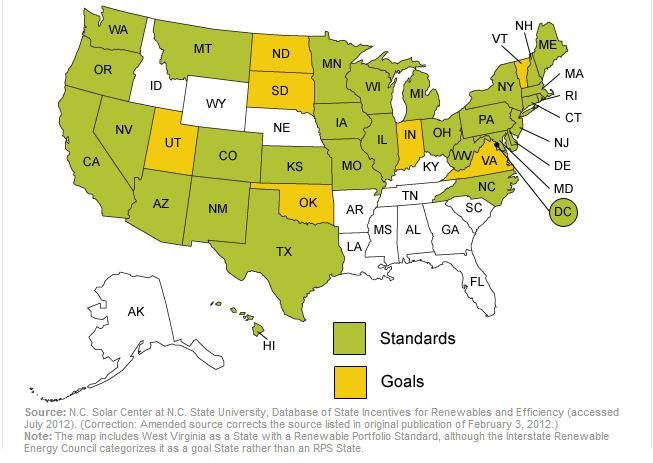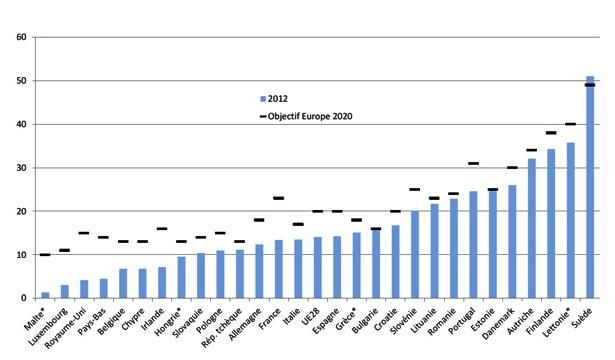From 2GreenEnergy Intern Oliver Goavec: Europeans and Americans Have Different Perceptions on Climate Change — Part Three of Three

– In 2002, the Clear Skies and Global Climate Change law. The objectives were to cut emissions of sulfur dioxide by 73%, nitrogen oxide by 67%, and mercury by 69%, with one emissions cap in 2010 and the other in 2018. It also provided more funding for the research and a tax-favorable treatment to those who invest in renewables.
– In 2005, during the 11th United Nations Framework Convention on Climate Change (UNFCCC) the U.S. agreed to join negotiation for international cooperation post-Kyoto. (2005), and became part of the Asia-Pacific Partnership for Clean Development and Climate Change, with Australia, India, Japan, China & South Korea and Canada, in order to develop green technologies. However, this partnership does not impose any objectives in term of gas emission reductions.
But most of the real measures against climate change are taken at the state level, thanks to Renewable Portfolio Standards (RPS), which encourage producers to develop renewable energy to produce electricity. As of today, 29 states and the district of Colombia have RPSs, as shown below.

These Renewable Portfolios Standards are more or less constraining according to the states, and the deadlines are not the same. We can see that there actually exist real green politics in the U.S., although we may regret the lack of real federal actions to harmonize the country and force everyone to set up measures in that way.
For the European Union, things are a bit different. The EU and its members (28 as of May 2014) defined an objective for each country in order to meet a global goal but each country decides its road map to match its objectives. A lack of cooperation with neighboring countries can sometimes affect the European grid. For example Germany and Spain installed a lot of wind turbines but when the wind is blowing on the whole country their electrical production is too high and they have to send this electricity to France, Belgium, etc. Those countries, in turn, must adapt their production accordingly by decreasing the part of nuclear or other fuels.
The percentage of energy from renewables per member country (in % of the final gross energy consumption) is presented here:

I hope this paper provided some clues to understand the difference in point of view between the U.S. and Europe vis-à-vis climate change. Where Europe has a roadmap, the U.S. is still without federal law to impose any real effort in the whole country. Nevertheless, a study made by the Business Council for Sustainable Energy and Bloomberg New Energy Financepointed out that between 2007 and 2012 the CO2 emissions in the U.S. have been cut by 13%. The main reason are the arrival of shale gas which, to a large degree, replaces coal, the installation of renewable energy which represent today 9.4% of the total energy consumption and the energy demand which has decrease by 6.4%.
Europe and the U.S. are making efforts in order to improve their ecological impact on Earth. In 2015, Paris will host the 21st session of the conference of the parties to the UNFCCC. Let’s all hope that the whole world will take its responsibility seriously, and pledge to create a better future.
Sources :
http://www.actu-environnement.com/ae/news/politique-energetique-etats-unis-petrole-eolien-10553.php4 (french)
http://www.ladocumentationfrancaise.fr/dossiers/changement-climatique/position-americaine.shtml (french)
http://www.citego.info/?Les-Etats-Unis-et-le-changement (french)
http://perspective.usherbrooke.ca/bilan/servlet/BMEve?codeEve=520 (french)
http://www.commission-petrole.fr/premier-choc-petrolier-la-guerre-du-kippour/ (french)
https://www.fas.org/sgp/crs/misc/R40187.pdf (english)
http://www.fern.org/fr/book/commercer-le-carbone/chapitre-1-les-origines-du-march%C3%A9-du-carbone (french)
http://www.globalpolicy.org/component/content/article/216/45883.html (english)
http://www.presidency.ucsb.edu/ws/?pid=45811 (english)
http://www.bcse.org/factbook/pdfs/2014%20Sustainable%20Energy%20in%20America%20Factbook.pdf (english)
annual energy outlook 2014 by the EIA (English)
